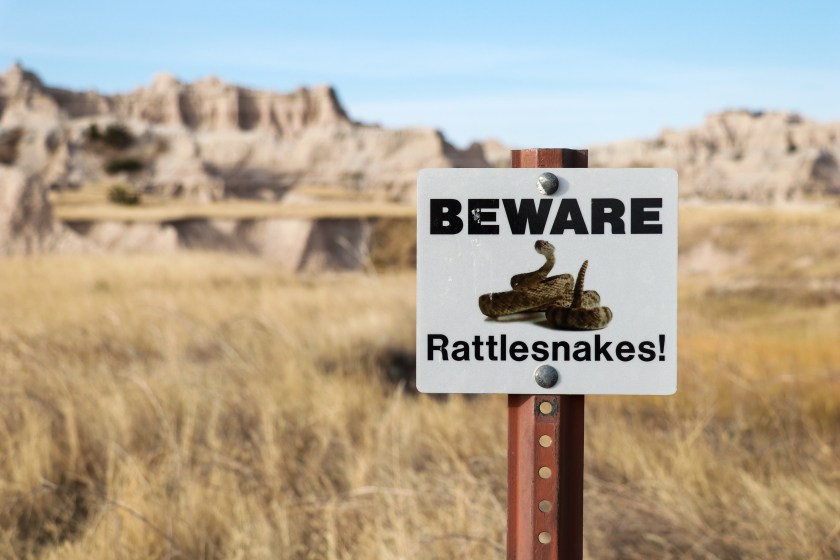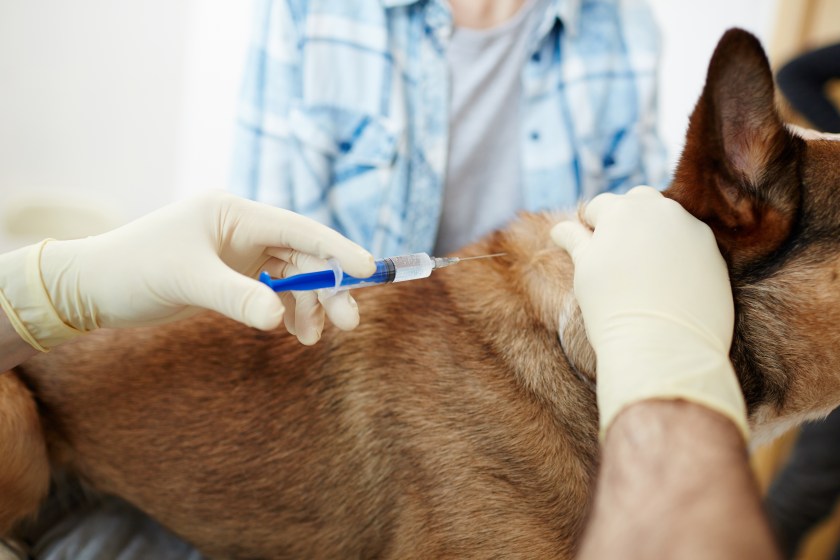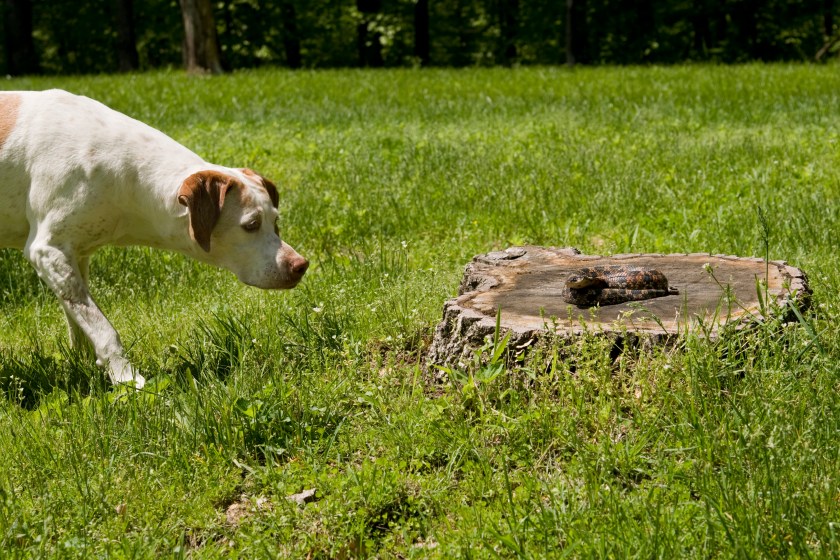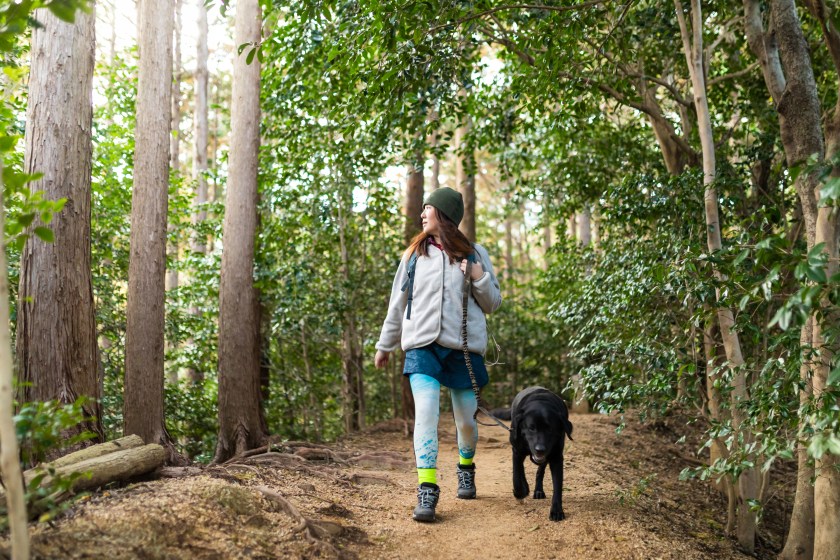Most hikers know the sound of a rattle out on the trail is a warning to heed. Step too close to a rattlesnake and they'll lash out and bite you. But while it can be easy to control your own steps at the sound of that telltale rattle, the four-legged steps of your dog hiking alongside you are harder to control—especially if you don't hear any warning sound from the snake. Dogs are, after all, sniffing, scratching, and interacting with their environments far closer to the ground than we are, and their biological makeup can make them more of a target.
Depending on where you take your dog hiking, this could mean the very real risk of rattlesnakes to our canine companions.
Rattlesnakes bite thousands of pets—including dogs—every year. Dogs are multiple times more likely to suffer a snake bite than people and are about 25 times more likely to die if bitten. Snake bites are not only more life-threatening to dogs, but they're also extremely painful, expensive to treat, and can cause permanent physical damage and psychological trauma—for both pup and owner!—if a dog survives the encounter.
So, how do we protect our beloved furry friends? One way is to get them the rattlesnake vaccine for dogs, Dr. Katie Leslie of Park Veterinary Hospital in Durham, North Carolina, tells Wide Open Spaces. Here's what you need to know.
What Does the Rattlesnake Vaccine for Dogs Do?

Getty Images, Daniel Kuster
The rattlesnake vaccine, made by Red Rock Biologics, is called Crotalus Atrox Toxoid and aims to minimize the severity of venomous snake bites in dogs. The vaccine, which is made from the venom of the western diamondback rattlesnake, works by stimulating the dog's immune system to produce antibodies against specific snake venom components. These antibodies can help neutralize the venom and reduce the impact of the bite on the dog's health.
Crotalus Atrox Toxoid works against most rattlesnake species, with the exceptions of cottonmouth, eastern diamondback, and coral snakes. It also provides cross-protection against copperhead bites.
Key Benefits of the Rattlesnake Vaccine
The rattlesnake vaccine works to lessen the severity of rattlesnake bites and can buy valuable time to get your pet to the vet in the case of a bite happening far off the beaten path. Dogs vaccinated against rattlesnake venom have a higher chance of survival and a decreased risk of long-term complications associated with snakebites.
Drawbacks of the Rattlesnake Vaccine
Unfortunately, the rattlesnake vaccine is not a catch-all solution: It does not provide complete immunity or eliminate the need for immediate medical attention. "Bites should still be treated as an emergency even for a vaccinated dog," says Dr. Leslie. This is particularly true if you aren't entirely sure what type of snake bit your pet.
Further, rattlesnake vaccine effectiveness can vary among individual dogs. It may still be worth it, though: Even partial protection can make a significant difference in the outcome of a snakebite.
How is the Rattlesnake Vaccine Administered?

Getty Images, shironosov
Dogs should receive two subcutaneous doses of rattlesnake vaccine about a month apart, and some vets recommend that some dogs receive a three-dose initial vaccination series, with annual boosters given about 30 days before the beginning of rattlesnake season.
Active snake season starts early spring and runs through the middle of fall—i.e., when the weather is warm—so getting vaccinated as soon as spring starts to break is ideal. Peak protection begins 30 to 45 days after boosters and lasts about six months. In warmer areas where snakes are active all year, your dog may need a vaccination every six months. If you miss a booster during the process, contact your vet for directions on what additional dosage is recommended for your particular dog.
Who Should Get a Rattlesnake Vaccine for Their Dog?

Getty Images, sbrogan
Doing the appropriate research and consultation with your vet is the best way to ensure that you protect pet health, and preparing for instances where your furry friend might suffer rattlesnake bites is paramount. Any dog more than four months old of any breed is a candidate to receive the vaccine, but dogs that are ill, have an immunosuppressive condition, or have had an adverse reaction to any other vaccine should not receive the rattlesnake vaccine.
Your specific geography, as well as the frequency you take them outdoors and on adventures where snakes live, will have a lot to do with your pet's snake-bite risk level. Rattlesnakes can be found all over the U.S., including the Eastern Massasauga Rattlesnake in the midwest, but are most prevalent in the Southwest. Rattlesnake vaccines can add an additional layer of protection for dog owners who live in those areas.
On the other hand, as the coral, cottonmouth, and eastern diamondback species of rattlesnake are not covered by the vaccine, pet owners in areas where those snakes live—southeastern North Carolina, extreme eastern Louisiana, as well as parts of Florida, central Texas, and most of Arizona—may still opt for the vaccine, but be extra-watchful and aware what those species look like.
What To Do if Your Dog has a Snake Bite
Any snake bite is cause for immediate medical attention. "Get your pet to a vet as soon as you can, and don't put anything on the wound or try to bandage it," says Dr. Leslie.
If you're not sure what bit your pet, she says the "key symptoms are pain and swelling, and you may see small puncture wounds or a little bit of bleeding or oozing at the site of the bite." On the other hand, if you see the predator strike, try to get a photo of it, which can help your vet with identification and treatment.
The vet will administer antivenom (also called "antivenin") in an effort to save your pet. Antivenom doses are different from the vaccine and are used to treat the acute symptoms of rattlesnake bites after the fact. In theory, antivenom can be purchased through your vet to have on hand, and the same dose is applicable to administer to your dog, no matter their size. But it's very expensive and may be cost-prohibitive (and often counterfeit, if purchased online), and you must be sure you know when and how to use it.
What Can You Do to Prevent Snake Bites?

Getty Images: petesphotography
As with many things, the best cure is prevention. Avoid areas or trails where you or your dog can't clearly see the ground, or where grasses or brush are high. Keep your dog on a leash while hiking, and if you live in an area where rattlesnakes frequent, keep your backyard clean and free of debris. Although rattlesnakes can be encountered at all hours and times of the year, these reptiles are more active during the summer months and before dawn and after dusk.
"There are also some training programs in high-risk areas that are meant to teach dogs to avoid snakes in the wild called rattlesnake aversion training," Dr. Leslie says. In these courses, trainers help dogs identify the movements, behaviors, and scent of rattlesnakes and avoid them if encountered.
The Bottom Line on the Rattlesnake Vaccine for Dogs
Your vet will be the best source of information regarding the rattlesnake vaccine, as they'll have specific veterinary care information to share with you about your local environment and how that may affect your dogs' safety and wellness. They'll evaluate your dog's specific needs, recommend an appropriate vaccination schedule—which may or may not mean a seasonal vaccination strategy—and address any concerns or questions you may have.
READ MORE: Dog First Aid Kit: 16 Essential Items to Pack, According to a Vet




